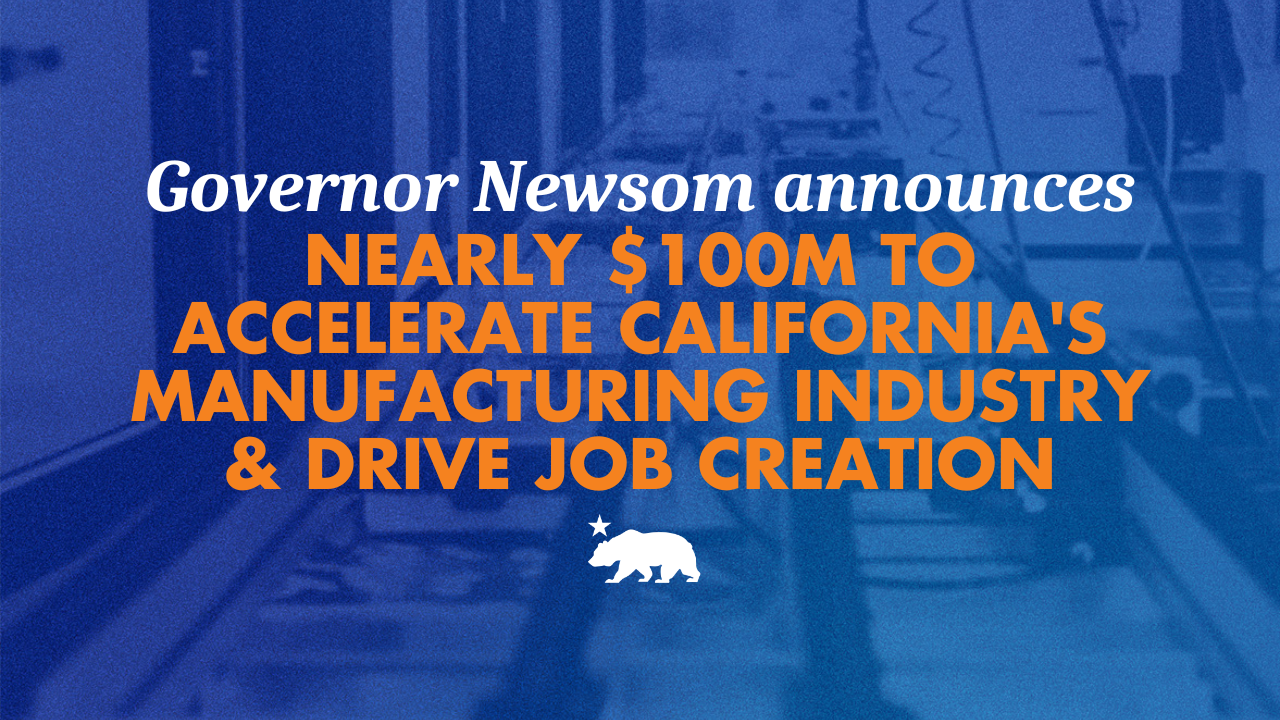Governor Newsom announces nearly $100M to accelerate California’s manufacturing industry and drive job creation – California State Portal | CA.gov

Report on California’s Economic Investment and Alignment with Sustainable Development Goals
Executive Summary
On November 17, 2025, the State of California announced the allocation of $99.9 million in California Competes Tax Credits (CalCompetes) to nine companies. This strategic investment, part of the California Jobs First initiative, is projected to generate over $370 million in private capital investment and create 2,752 new full-time jobs with a weighted average annual salary of $139,000. The initiative directly supports California’s economic growth by expanding manufacturing operations and headquarters across diverse, innovative sectors. This report analyzes the investment’s significant contributions to several United Nations Sustainable Development Goals (SDGs), particularly SDG 8 (Decent Work and Economic Growth) and SDG 9 (Industry, Innovation, and Infrastructure).
Alignment with Sustainable Development Goals (SDGs)
SDG 8: Decent Work and Economic Growth
The CalCompetes awards program is a direct implementation of SDG 8, which aims to promote sustained, inclusive, and sustainable economic growth, full and productive employment, and decent work for all. The initiative achieves this through:
- Job Creation: The creation of 2,752 new, high-quality jobs across the state.
- High-Value Employment: The average weighted annual salary of $139,000 for the new positions significantly contributes to economic prosperity and financial security for workers.
- Economic Diversification: Investment spans multiple high-value manufacturing sectors, strengthening California’s economic resilience and promoting higher levels of economic productivity.
SDG 9: Industry, Innovation, and Infrastructure
The funding round places a strong emphasis on fostering innovation and building resilient infrastructure, which are core targets of SDG 9. The selected companies are at the forefront of technology and advanced manufacturing:
- Promoting Innovation: Investments in companies like Atomic Machines Inc. (micro-electromechanical systems), Hadrian Automation, Inc. (aerospace), and True Anomaly (satellites) drive technological advancement.
- Upgrading Infrastructure: The expansion of manufacturing facilities for data centers, aerospace components, and diagnostic devices represents a significant upgrade to California’s industrial infrastructure.
- Fostering Sustainable Industries: The awards support sectors identified in the state’s Economic Blueprint as critical for future growth, ensuring a forward-looking industrial strategy.
Contributions to Additional SDGs
The investment portfolio also advances other critical global goals:
- SDG 6 (Clean Water and Sanitation): The investment in Community Infrastructure Investment Group, Inc. to establish a wastewater treatment equipment manufacturing facility directly supports the infrastructure needed for sustainable water management.
- SDG 3 (Good Health and Well-being): Funding for Bella Phytologic (vitamin manufacturing) and Pacific Scientific Energetic Materials Company (diagnostic and measurement devices) contributes to the health and wellness sector.
- SDG 12 (Responsible Consumption and Production): Support for advanced manufacturing encourages more efficient and sustainable production patterns. Furthermore, the investment in Gimme Health Foods Inc. for seaweed-based products promotes sustainable food sources.
- SDG 11 (Sustainable Cities and Communities): By distributing investments across various regions including Santa Clara, Fremont, Torrance, Fresno, and Madera, the initiative promotes inclusive and sustainable urbanization and strengthens local economies.
Detailed Investment and Impact Analysis
Recipient Companies and Projected Outcomes
The $99.9 million in tax credits were awarded to nine companies, with investments and job creation allocated as follows:
- Atomic Machines Inc.: Investing $156.3 million to expand micro-electromechanical system manufacturing, creating 305 jobs.
- Bright Machines: Investing $62.9 million to scale data center infrastructure manufacturing, creating 295 jobs.
- Hadrian Automation, Inc.: Investing $52 million in aerospace component manufacturing, creating 650 jobs.
- Bella Phytologic: Investing $33 million in vitamin and supplement manufacturing facilities.
- Gimme Health Foods Inc.: Investing $20 million to establish a seaweed food manufacturing facility, creating 102 jobs.
- Pacific Scientific Energetic Materials Company (California) LLC: Investing $18 million to expand its diagnostic and measurement device facility.
- Community Infrastructure Investment Group, Inc.: Investing $12.8 million to establish a wastewater treatment equipment facility.
- True Anomaly: Investing $12.7 million to expand satellite manufacturing, creating 400 jobs.
- Color Image Apparel: Investing $2.5 million to expand its headquarters, adding 774 jobs.
Analysis of Sustainable Development Goals
1. Which SDGs are addressed or connected to the issues highlighted in the article?
The article highlights several issues that are directly connected to the Sustainable Development Goals. The primary focus on job creation, economic growth, and investment in manufacturing aligns with multiple SDGs. The specific industries receiving support, such as wastewater treatment and innovative technologies, further broaden the scope of relevant goals.
- SDG 8: Decent Work and Economic Growth: The core of the article is about the “California Jobs First initiative,” which aims to create “thousands of new jobs” and drive economic growth. The announcement details the creation of “2,752 new jobs with an average weighted annual salary of $139,000,” directly addressing the goal of promoting full and productive employment and decent work for all.
- SDG 9: Industry, Innovation and Infrastructure: The article focuses on accelerating California’s manufacturing industry through investments in “innovative companies” across sectors like “aerospace, wastewater treatment, and microelectronics.” This initiative supports building resilient infrastructure, promoting inclusive and sustainable industrialization, and fostering innovation. The state is investing in the “workforce, infrastructure and innovation that drive the growth of this critically important sector.”
- SDG 6: Clean Water and Sanitation: The article explicitly mentions an investment in a company that contributes to this goal. The “Community Infrastructure Investment Group, Inc. will invest $12.8 million to establish its wastewater treatment equipment manufacturing facility in Fresno.” This investment supports the development of infrastructure necessary for managing water resources and sanitation.
2. What specific targets under those SDGs can be identified based on the article’s content?
Based on the initiatives and outcomes described in the article, several specific SDG targets can be identified:
-
Under SDG 8 (Decent Work and Economic Growth):
- Target 8.2: Achieve higher levels of economic productivity through diversification, technological upgrading and innovation. The article supports this by funding a “diverse range of manufacturers” in high-tech sectors like “aerospace” and “micro-electromechanical system manufacturing.”
- Target 8.3: Promote development-oriented policies that support productive activities, decent job creation, and innovation. The “California Competes Tax Credits” program is a direct example of such a policy, designed to attract companies and help them grow, “creating good-paying jobs and opportunities for Californians.”
- Target 8.5: Achieve full and productive employment and decent work for all. The initiative’s goal of creating “2,752 new jobs” with a high average salary of “$139,000” directly contributes to this target.
-
Under SDG 9 (Industry, Innovation and Infrastructure):
- Target 9.2: Promote inclusive and sustainable industrialization. The article highlights that the manufacturing sector is being strengthened, delivering “$405.6 billion in output in 2024 and employing more than 1.24 million workers,” with the new investments aiming to increase this share.
- Target 9.b: Support domestic technology development, research and innovation. The investment in companies like “Atomic Machines Inc.” for micro-electromechanical systems and “True Anomaly” for satellite manufacturing demonstrates support for domestic innovation and advanced technology.
-
Under SDG 6 (Clean Water and Sanitation):
- Target 6.3: Improve water quality by reducing pollution and treating wastewater. By funding the establishment of a “wastewater treatment equipment manufacturing facility,” the state is directly supporting the capacity to achieve this target.
3. Are there any indicators mentioned or implied in the article that can be used to measure progress towards the identified targets?
Yes, the article provides several quantitative and qualitative indicators that can be used to measure progress towards the identified targets.
-
For SDG 8 Targets:
- Number of new jobs created: The article explicitly states an estimated “2,752 new jobs” will be created. This is a direct indicator for Target 8.5.
- Quality of jobs: The “average weighted annual salary of $139,000” is a key indicator of decent work.
- Total private investment generated: The initiative is expected to “bring in more than $370 million in new private investment,” which measures economic growth and the effectiveness of the state’s policy (Target 8.3).
-
For SDG 9 Targets:
- Investment in manufacturing and infrastructure: The article lists specific capital investments by companies, such as Atomic Machines Inc. “investing $156.3 million” and Bright Machines making a “$62.9 million investment.” These figures serve as indicators of industrial investment.
- Manufacturing sector output: The mention of the manufacturing sector delivering “$405.6 billion in output in 2024” provides a baseline indicator for Target 9.2.
- Manufacturing employment: The figure of “more than 1.24 million workers” in the manufacturing sector is an indicator for Target 9.2, with the new jobs adding to this total.
-
For SDG 6 Targets:
- Investment in water and sanitation-related industries: The “$12.8 million” investment to establish a wastewater treatment equipment facility is a specific indicator of progress in building capacity for water management (Target 6.3).
4. Summary Table of SDGs, Targets, and Indicators
| SDGs | Targets | Indicators |
|---|---|---|
| SDG 8: Decent Work and Economic Growth |
|
|
| SDG 9: Industry, Innovation and Infrastructure |
|
|
| SDG 6: Clean Water and Sanitation |
|
|
Source: gov.ca.gov
What is Your Reaction?
 Like
0
Like
0
 Dislike
0
Dislike
0
 Love
0
Love
0
 Funny
0
Funny
0
 Angry
0
Angry
0
 Sad
0
Sad
0
 Wow
0
Wow
0
















































:focal(1500,1000)/https://media.globalcitizen.org/a6/9a/a69a4720-d8a1-4715-b596-18738d03c05c/rotary_polio_hero_image.jpg?#)







/countries/sri-lanka/photo-credit---dmc-sri-lanka.tmb-1200v.jpg?sfvrsn=dc298bcc_1#)

















